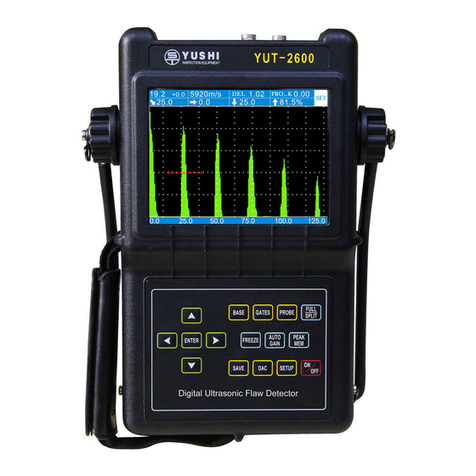
YUSHI INSTRUMENTS
3.4.1 Gate A menu.................................................................................................................................................12
3.4.1.1 Starting of gate A.......................................................................................................................................12
3.4.1.2 Width of gate A......................................................................................................................................... 12
3.4.1.3 Height of gate A........................................................................................................................................ 12
3.4.1.4 Mode of gate A..........................................................................................................................................13
3.4.1.5 Display choice...........................................................................................................................................13
3.4.2 Gate B menu ...............................................................................................................................................13
3.4.2.1 Starting of gate B.......................................................................................................................................13
3.4.2.2 Width of gate B......................................................................................................................................... 14
3.4.2.3 Height of gate B........................................................................................................................................ 14
3.4.2.4 Mode of gate B..........................................................................................................................................14
3.4.2.5 Measuring point.........................................................................................................................................14
3.5 PROBE MENU...........................................................................................................................................15
3.5.1 Dual probes.................................................................................................................................................. 15
3.5.2 Probe zero.....................................................................................................................................................15
3.5.3 Probe K value...............................................................................................................................................15
3.5.4 Front distance............................................................................................................................................... 15
3.5.5 Work piece thickness....................................................................................................................................16
3.5.6 Probe type.....................................................................................................................................................16
3.5.7 Probe frequency............................................................................................................................................16
3.5.8 Probe diameter..............................................................................................................................................16
3.6 DAC MENU............................................................................................................................................ 17
3.6.1 DAC echo.....................................................................................................................................................17
3.6.2 Gate A start...................................................................................................................................................17
3.6.3 Distance compensation.................................................................................................................................17
3.6.4 DAC curve mode..........................................................................................................................................18
3.6.5 RL.................................................................................................................................................................18
3.6.6 SL................................................................................................................................................................. 18
3.6.7 EL.................................................................................................................................................................18
3.7 AVG MENU............................................................................................................................................... 18
3.7.1 AVG mode.................................................................................................................................................... 18
3.7.2 Gate Astart....................................................................................................................................................19
3.7.3 Sensitivity.....................................................................................................................................................19
3.7.4 AVG curve.................................................................................................................................................... 19
3.7.5 φ value calculation....................................................................................................................................... 19
3.8 MEMORY MENU.................................................................................................................................................... 19
3.8.1 Memory number...........................................................................................................................................19
3.8.2 Call-out.........................................................................................................................................................20
3.8.3 Storage..........................................................................................................................................................20
3.8.4 Deletion........................................................................................................................................................ 20
3.8.5 Communication............................................................................................................................................ 20
3.9 OPERATION OF OTHER SPECIAL FUNCTIONAL KEYS................................................................................. 20
3.9.1 Automatic gain............................................................................................................................................. 20
3.9.2 Freezing........................................................................................................................................................21
3.9.3 Wave peak memory...................................................................................................................................... 21
3.9.4 Full screen.................................................................................................................................................... 22
































